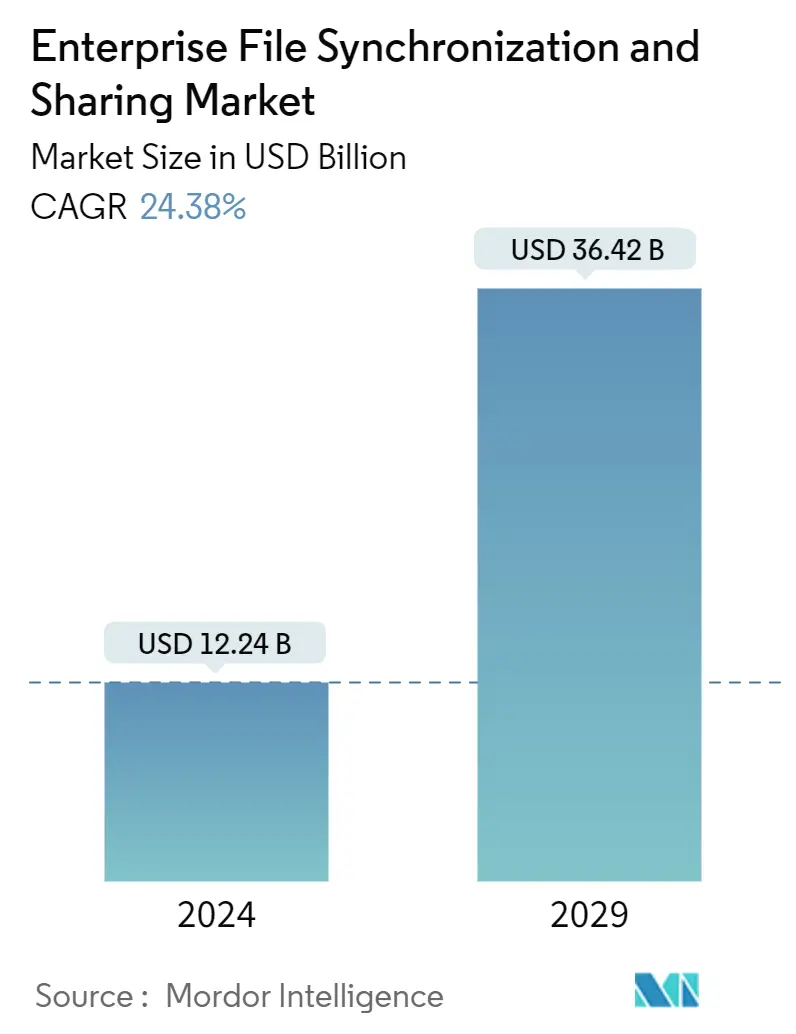Market Size of Enterprise File Synchronization And Sharing Industry

| Study Period | 2019 - 2029 |
| Market Size (2024) | USD 12.24 Billion |
| Market Size (2029) | USD 36.42 Billion |
| CAGR (2024 - 2029) | 24.38 % |
| Fastest Growing Market | Asia Pacific |
| Largest Market | North America |
| Market Concentration | Low |
Major Players
*Disclaimer: Major Players sorted in no particular order |
Enterprise File Synchronization And Sharing Market Analysis
The Enterprise File Synchronization And Sharing Market size is estimated at USD 12.24 billion in 2024, and is expected to reach USD 36.42 billion by 2029, growing at a CAGR of 24.38% during the forecast period (2024-2029).
Enterprise file synchronization and sharing (EFSS) is a software service that enables organizations to synchronize and share documents, photos, videos, and files securely.
- Organizations adopt these technologies to help employees avoid using consumer-based file-sharing applications and software to store, access, and manage to ensure data security. For instance, an enterprise workstation dominantly uses Windows, Mac OS, and Linux OS. In contrast, their employees use mobile devices, such as tablets and smartphones, use Android and iOS as the dominant operating systems. It creates a considerable challenge for an organization/institution to create a solution supporting these platforms. This led to the emergence of multiple players in the market that offer EFSS solutions.
- Businesses use EFSS to improve content management, collaboration, and secure file sharing and include features such as live commenting, document version tracking, and workflow process management to help users store, edit, review, and share files.
- It also offers the option to track and trace the document related to any invoice or order in auditing. Large enterprises that utilize EFSS require the flexibility to add access policies that govern the organization's accessibility to access specific content. These products include security capabilities, such as authentication, data encryption, containerization, and tracking features to protect enterprise data. Enterprises have been trying to improve their internal work efficiency by saving their employees time consumed in collaboration, as these solutions enable real-time collaboration and sharing of ideas.
- The increasing adoption of the BYOD policy is driving the market. The growing mobile and digital workplace trends have positively driven the market's growth. File sharing and synchronization tools have become an essential productivity-enabling resource for increasingly mobile information workers, driven by the BYOD policy.
- With the increasing demand for content and information security, enterprises are looking for more advanced solutions than the cloud. Weaknesses in cloud security include theft, sophisticated attacks against the application provider, and the inability to monitor data moving to and from applications. To overcome these, enterprises are launching new solutions.
- However, the organizations also encourage distributing their hardware for the prevalent hybrid work models to ensure uncompromised data security and work quality. Such measures potentially threaten the EFSS market, limiting the precedented growth with concepts like BYOD. The companies continue to use EFSS solutions on their proprietary devices for remote working.
- Further, the COVID-19 pandemic worldwide was anticipated to augment the demand for enterprise file synchronization and sharing, especially among the IT and telecom sectors, due to the feasibility of employees' working from home. This significantly drove the demand for safer enterprise file access, synchronization, and sharing solutions. As a result of the WFH onslaught, companies witnessed stepped-up sales, providing multiple access points and new-age features to ensure smooth and mission-critical performance in client organizations.
Enterprise File Synchronization And Sharing Industry Segmentation
The enterprise file synchronization and sharing service allows users to save files such as documents, photos, and videos in the cloud or on-premises storage and then access them on other computing devices with multiple people. Increasing privacy and security concerns, the service demand for all organization sizes is growing, comprising various end-user Vertical, such as Telecom and IT, BFSI, Retail, and Manufacturing.
The enterprise file synchronization and sharing market is segmented by service (managed services, professional services), size of enterprise (small and medium enterprises, large enterprises), deployment (cloud, on-premise), end-user vertical (IT & telecom, banking, financial services, and insurance, retail, manufacturing, education, government), and Geography (North America, Europe, Asia-Pacific, Latin America, Middle East & Africa). The market sizes and forecasts are provided in terms of value in (USD) for all the above segments.
| Service | |
| Managed Service | |
| Professional Service |
| Size of Enterprise | |
| Small and Medium Enterprises | |
| Large Enterprises |
| Deployment Type | |
| On-premise | |
| Cloud |
| End-user Vertical | |
| IT & Telecom | |
| Banking, Financial Services and Insurance | |
| Retail | |
| Manufacturing | |
| Education | |
| Government | |
| Other End-user Verticals |
| Geography | |
| North America | |
| Europe | |
| Asia-Pacific | |
| Latin America | |
| Middle East and Africa |
Enterprise File Synchronization And Sharing Market Size Summary
The Enterprise File Synchronization and Sharing (EFSS) market is poised for significant growth, driven by the increasing need for secure and efficient file management solutions within organizations. EFSS technologies enable businesses to synchronize and share documents, photos, videos, and files securely, helping to mitigate the risks associated with consumer-based file-sharing applications. As organizations adopt Bring Your Own Device (BYOD) policies and embrace mobile and digital workplace trends, the demand for EFSS solutions has surged. These solutions offer features such as live commenting, document version tracking, and workflow process management, which enhance content management, collaboration, and secure file sharing. The market is characterized by the presence of multiple players offering diverse EFSS solutions, catering to the needs of large enterprises that require robust security capabilities, including authentication, data encryption, and tracking features.
The EFSS market is experiencing heightened demand, particularly in sectors such as banking, financial services, and insurance (BFSI), where data security is paramount due to the prevalence of data breaches and identity thefts. The COVID-19 pandemic further accelerated the adoption of EFSS solutions as companies sought to facilitate remote work while ensuring data security. The market is fragmented and competitive, with major players like Microsoft, Dropbox, Citrix, Google, and VMware actively expanding their offerings through new product launches and strategic partnerships. North America, with its significant presence of managed services and IT vendors, is a key region driving market growth. Regulatory measures such as the California Consumer Privacy Act (CCPA) and Canada's Personal Information Protection and Electronic Documents Act (PIPEDA) are also influencing the market, as organizations seek to comply with stringent data privacy requirements.
Enterprise File Synchronization And Sharing Market Size - Table of Contents
-
1. MARKET DYNAMICS
-
1.1 Market Overview
-
1.2 Industry Attractiveness - Porter's Five Forces Analysis
-
1.2.1 Bargaining Power of Suppliers
-
1.2.2 Bargaining Power of Consumers
-
1.2.3 Threat of New Entrants
-
1.2.4 Threat of Substitutes
-
1.2.5 Intensity of Competitive Rivalry
-
-
1.3 Industry Value Chain Analysis
-
-
2. MARKET SEGMENTATION
-
2.1 Service
-
2.1.1 Managed Service
-
2.1.2 Professional Service
-
-
2.2 Size of Enterprise
-
2.2.1 Small and Medium Enterprises
-
2.2.2 Large Enterprises
-
-
2.3 Deployment Type
-
2.3.1 On-premise
-
2.3.2 Cloud
-
-
2.4 End-user Vertical
-
2.4.1 IT & Telecom
-
2.4.2 Banking, Financial Services and Insurance
-
2.4.3 Retail
-
2.4.4 Manufacturing
-
2.4.5 Education
-
2.4.6 Government
-
2.4.7 Other End-user Verticals
-
-
2.5 Geography
-
2.5.1 North America
-
2.5.2 Europe
-
2.5.3 Asia-Pacific
-
2.5.4 Latin America
-
2.5.5 Middle East and Africa
-
-
Enterprise File Synchronization And Sharing Market Size FAQs
How big is the Enterprise File Synchronization And Sharing Market?
The Enterprise File Synchronization And Sharing Market size is expected to reach USD 12.24 billion in 2024 and grow at a CAGR of 24.38% to reach USD 36.42 billion by 2029.
What is the current Enterprise File Synchronization And Sharing Market size?
In 2024, the Enterprise File Synchronization And Sharing Market size is expected to reach USD 12.24 billion.

